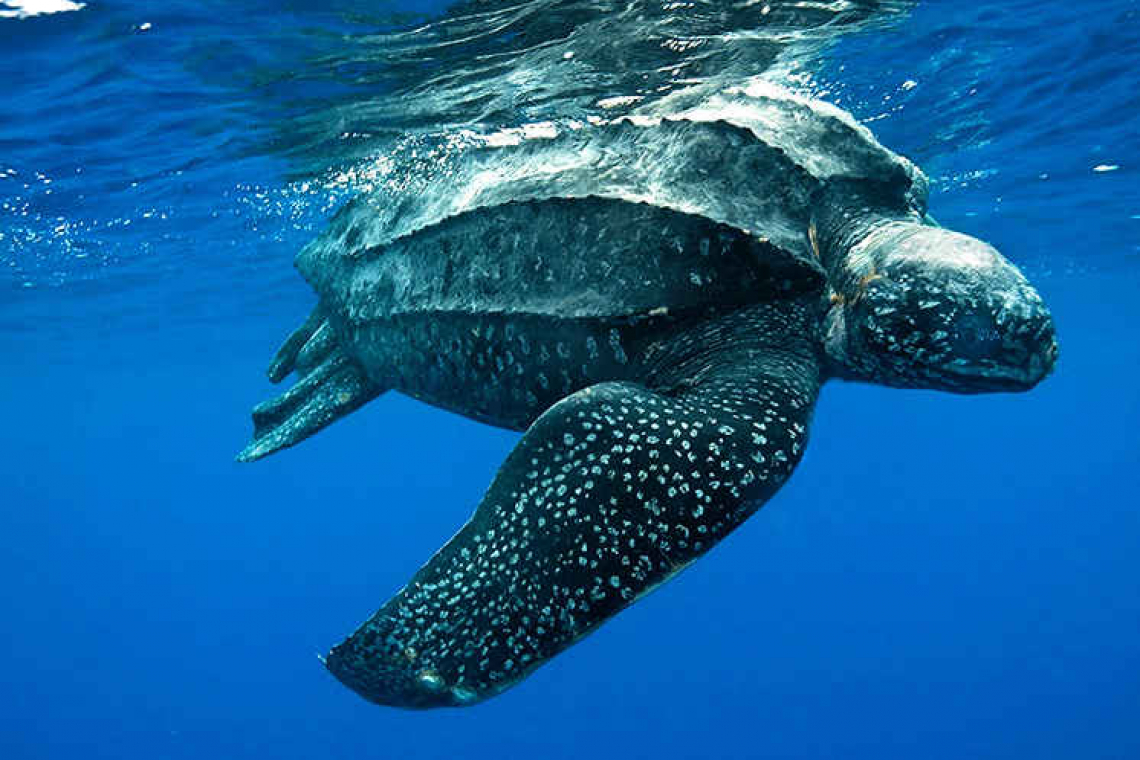Picture: The Leatherback, credit NOAA Fisheries.
By Nature Foundation St. Maarten
In the last edition of The KIDS Herald, published July 13, we asked: “What are the four most common sea turtle species found in our Caribbean waters?”
The answer:
* The Green Turtle, which has an olive brown shell, pale yellow belly, and two large scales between the eyes.
* The Loggerhead, which is red-brown to brown, and has a big head.
* Hawksbill turtle, which is mostly brown, orange and yellow, and has four scales between the eyes
* The Leatherback, which has no body shell. Instead it has a leathery back with seven lines, and black and white spots.
In this edition, we introduce Turtle Talks, where we interview Lara Leatherback about life in our Caribbean waters.
Interviewer: Hi Lara, how are you today? Can you tell me a bit about yourself?
Lara: Hi, I’m Lara Leatherback, and from my last name, you can tell that I am family to the Leatherback species. I was born right here on St. Maarten, 40 years ago. I have traveled around the world for decades, but most recently, I returned to St. Maarten so I can nest. No matter how far away they travel, sea turtles always return to the same area/beach that they hatched from to lay their eggs.
Interviewer: Oh wow, that is impressive! If you have traveled around the world, how do you know how to return here?
Lara: I rely on Earth's magnetic field to find my way home. That's because each part of the coastline has its own magnetic signature, which turtles may remember and later use as an internal compass.
Interviewer: That is amazing! So where are the nesting areas here on the island?
Lara: Nesting on St. Maarten often occurs on Simpson Bay Beach, Guana Bay Beach, Dawn Beach and Mullet Bay Beach. That is mainly because these beaches do not have as many developments or activities as other local beaches. Mullet Bay beach is a popular beach for tourists and locals, and because of this, there have been more activities in the past couple of years. This makes it more difficult for us sea turtles to nest.
Interviewer: Why is that? Can you explain a bit more?
Lara: I see jet ski’s coming closer to the beaches, I see boats and catamarans anchoring nearby, I see new buildings and more beach chairs. These are things that people enjoy when on the beach, but it stops us turtles and other sea creatures from thriving. Boats and jet skis often hurt or kill us, new buildings and marinas take up our natural spaces, and beach chairs, litter, or even sand castles can block hatchlings from finding their way to the sea. Human-associated stresses are one of the main reasons that sea turtles are endangered.
Interviewer: I’m so sorry to hear this. So how do you know that where you nested is safe?
Lara: I laid my eggs at the Simpson Bay Beach, close to Karakter. I can only hope that they will be safe there. My human friends at Nature Foundation did mark off the area, so that everyone can see that they should keep a distance. A Green Sea Turtle friend of mine also nested near the Azure hotel and that area is marked off too. I hope that by the end of July, my eggs will hatch and that my hatchlings will be able to swim to the sea.
Interviewer: Will you be around to guide them and nurse them?
Lara: That is not necessary, because once the eggs are hatched, the baby turtles are fully equipped to hunt and forage for themselves. Mother sea turtles do not nurse their hatchlings.
Interviewer: Oh wow. I did not know that! Do you have any other interesting turtle facts to share?
Lara: I do! The gender of the sea turtle is determined by the temperature of the sand. Warm sand makes female sea turtles; cooler sand makes male turtles. With global warming issues rising, this can bring a disbalance between male and female turtles, so it remains important that humans take care of nature.
Another sea turtle fact: From the four sea turtle species that swim in our waters, the Loggerhead species is the only one that has no records of nesting on St. Maarten beaches. Local environmentalists believe that this is because Loggerheads prefer to swim in warm, shallow waters where they can find plenty of food, like jellyfish and crabs, and that is where many fishing activities also take place. That can lead to relatively more Loggerheads being trapped, injured and killed by nets and hooks, and so these female turtles don’t mature enough to mate and lay eggs. Loggerheads also prefer steeply sloped, deep beaches to nest, but Coastal developments have impacted our natural beaches, so perhaps this has kept Loggerheads from nesting on our beaches.
Interviewer: Thank you so much for this turtle talk, Lara. I have learned so much about Sea Turtles on St. Maarten.
Lara: You’re most welcome. I hope to be back in two or three years to lay some eggs again!
Definitions:
* Occurs: happens.
* Thriving: to be developing and doing well.
* Hatchlings: baby turtles.
* Human associated stresses: problems or tensions caused by human beings.
* Forage: search widely for food or provisions.
* Environmentalists: persons who are concerned about protecting the environment.
Sources: Nature Foundation St. Maarten, NOAA Fisheries, Aquarium Biarritz, Conserveturtles.org.







